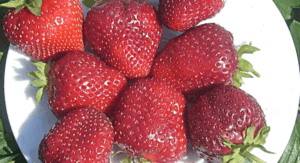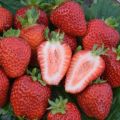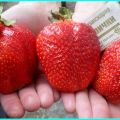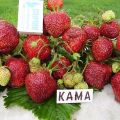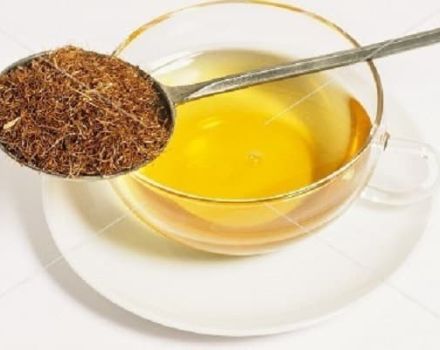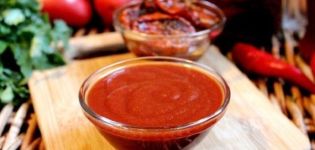Description and characteristics of Bohema strawberries, planting and care
Late-ripening strawberry variety Bohemia was bred by Russian scientists for cultivation in the Central region. Garden strawberries have received recognition from farmers, summer residents for undemanding growing conditions, large fragrant fruits.
Description and characteristics of the Bohemian variety
Erect tall strawberry bushes are characterized by strong roots, large leaves with medium wrinkles with denticles at the edges. The leaf plates located closer to the root are of a rich dark green color, the upper ones are 1–2 tones lighter.
Thick peduncles grow flush with the leaves, under the weight of the crop, reaching 2 kg per bush, lie on the soil. Flowers - white, collected in inflorescences. Powerful whiskers are few in number.
Dark red fruits in the form of a wide cone or comb-like - large (up to 50 g), sugary, with a pronounced characteristic aroma and gloss. The peculiarity of the hybrid berries is their green color and split at the end, a high content of ascorbic acid.
The first berries, which ripen by mid-July, are larger. By the end of the season, the strawberries become smaller.
Qualities such as winter hardiness and drought resistance make it possible to grow a crop not only in the recommended Central Russia, but also in southern regions, areas with cold winters.

Pros and cons of strawberries
Summer residents and farmers speak positively about Bohemia strawberries. Of the positive characteristics are:
- high transportability due to the density of the fruit structure;
- unpretentiousness to climatic conditions, soils;
- winter hardiness;
- drought resistance;
- immunity to viruses and fungal diseases;
- large, dessert-flavored fruits.
The disadvantages of Bohemia are the heterogeneity of the mass of berries, the average yield is 3.5 kg per 1 sq. m. When grown for sale, farmers attribute the green, forked tip of the fruit to the disadvantages.
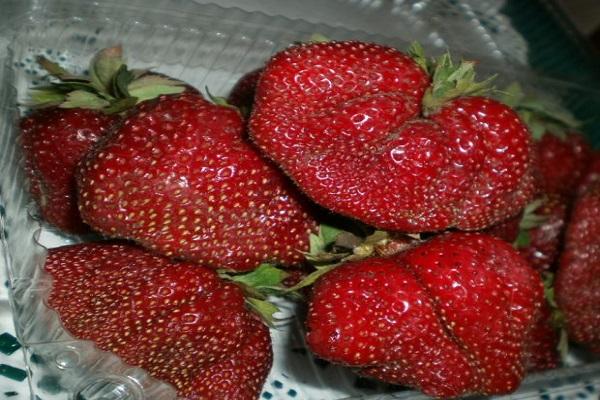
How to grow
Undemanding to growing conditions does not mean that the crop is cultivated in any area. They plant Bohemia strawberries at a certain time on prepared beds, choosing high-quality planting material.
Selection and preparation of a place for a garden
Lowlands with waterlogged soil and steep slopes, on which the soil is washed out when the snow melts, are not suitable for strawberries of the Bohemian variety.
The optimal area for a plant is a flat, dry place well-lit by the sun. A slight shading of strawberries does not harm, but when planted in the shade of the crowns of adult trees, the fruits become smaller. The strawberry bed is pre-dug onto the bayonet of a shovel, clearing it of weeds. The most suitable soil is fertile loam.
Since Bohemia does not like fertilizing under the bush, the necessary microelements are brought in for digging and they wait a month to transform them into a form assimilable by the culture.

For 1 sq. m add a bucket of humus, compost or rotted manure, or add nitroammofosku (50 g per 1 sq. m).
If the groundwater is above 70 cm from the surface, ridges are raised.
Strawberries cannot tolerate acidic soils. If the pH does not correspond to the indicators of 5.5-7, the soil is alkalized with lime, ash.
Preparation of planting material
When purchasing young Bohemian bushes, in licensed nurseries or large horticultural farms, they pay attention to the development of the root system. Length - not less than 10 cm, if more - cut. Leaf plates in the amount of 3-5 pieces should not be dried out and with signs of spotting.
The larger the central red bud, the more likely it is to get a bountiful harvest in the year of planting. The age of the strawberry is determined by the thickness of the growth point. Mature bushes with a thick "heart" are not suitable as planting material.
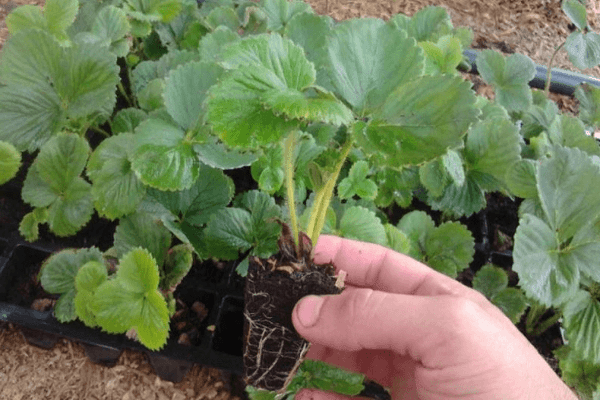
Two hours before planting, the roots of the seedlings are soaked in a purchased growth stimulant, vitamin infusion of nettle or a garlic solution with a smell that repels insect pests.
Planting process
The culture is planted in the spring when the soil warms up to + 10 ° C or in August. Quality material (mustache of the first and second order) appears in the summer. If you plant Bohemia strawberries in September or October, the plants will not have time to prepare for winter, the next year's harvest will not please with abundance.
The distance in the row between the seedlings of garden strawberries is maintained at 30–40 cm. The growth point remains on the outside flush with the surface or slightly higher.
After covering the strawberries with a substrate, the soil is compacted, watered, the bushes are mulched.

Leaving after disembarkation
Further care of the crop includes moistening the soil, feeding, weeding, protection from diseases and pests.
Watering
Bohemia strawberries need regular, moderate irrigation. Plants lose part of the harvest when there is a lack of moisture, although they are drought-resistant varieties. With excessive watering, the development of the bushes is inhibited.
Freshly planted seedlings and mature bushes especially need watering for the first 2 weeks during the active growing season from May to September. At this time, moisturizing after two days is recommended.
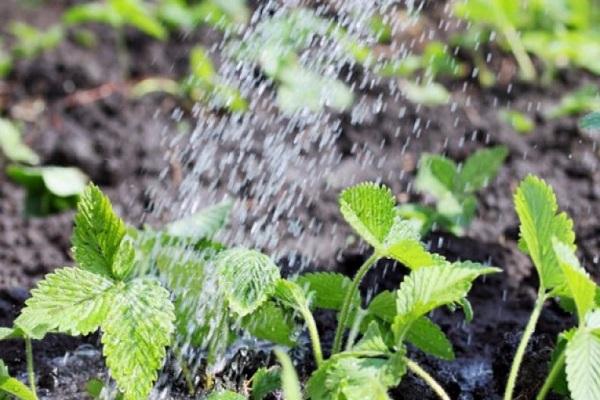
Fertilizers
In addition to the introduction of organic matter, mineral complexes before planting, Bohemia strawberries need additional feeding during the season.
When the ground dries up after the snow melts, the bed is watered with infusion of mullein or bird droppings. If in the future nitrogen interferes with the formation of Bohemian ovaries, immediately after the end of winter, a microelement is necessary for the culture. If there is no organic matter, it is replaced by urea. Under each bush poured 500 g of a solution prepared from 50 g of carbamide, 10 l of water.
During the budding period, the plants are fertilized with nitroammophos, before the formation of the ovary - with boron. To prepare the solution, add 2 g of boric acid to a bucket of water.
During the filling of green fruits, the culture is fed with mullein infusion (10 l) with the addition of ash (200 g) and nitroammofoska (30 g).
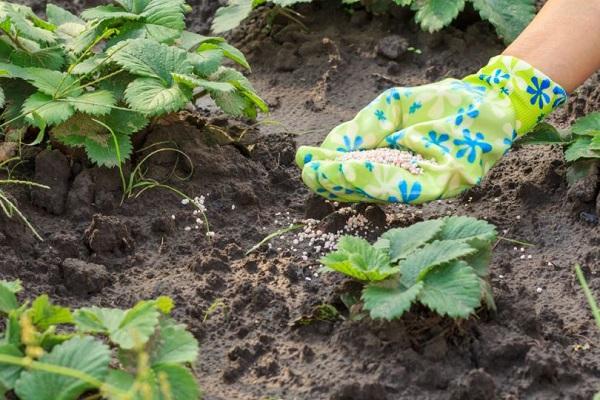
For the last fifth time, Bohemia is fertilized after harvest, when flower buds are laid the following year. Sprinkle the bed with ash at the rate of 1 kg per 1 sq. m, watered, embedded in the ground with a hoe.
Diseases and pests
Bohemia strawberries are not susceptible to late blight, fusarium, gray rot, powdery mildew, and other diseases characteristic of garden strawberries.
The variety is resistant to nematodes and ticks, but for safety reasons, gardeners in the spring treat the bushes with Aktellik, Inta-vir, Agravertin according to the instructions for use. Toxic drugs are successfully replaced with a safe biological Fitosporin.In the fight against ticks, Aktofit helps.

Collection and storage
To extend the freshness of the harvest for at least a few days, the fruits are removed from the bushes 2-3 days before they are fully ripe. The berries are harvested from mid-June to September. The event is carried out in clear weather in the morning after the dew dries or in the evening before it falls out.
To increase the shelf life, strawberries cannot be transferred from one container to another. The berries are harvested directly into containers where the harvest will be stored.
When cooled quickly in the refrigerator, Bohemia fruits remain fresh for up to four days, if the bottom of the container is lined with paper, the berries are laid out in 1 row.
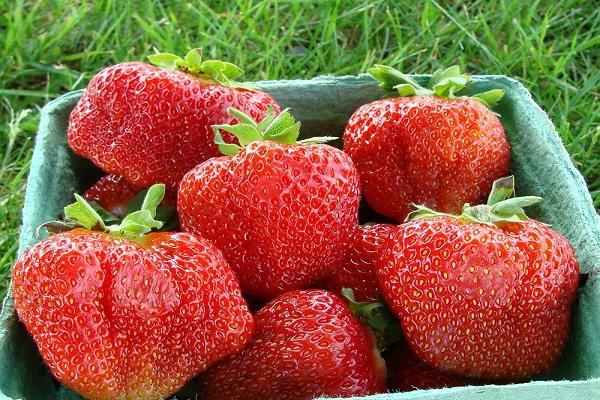
At room temperature, strawberries retain their original state for 24 hours. To prolong storage, the fruits are frozen or ground with sugar.
Bohemia strawberry is a variety loved by gardeners for its positive characteristics that reduce labor costs when caring for a crop.
Farmers, not taking into account minor shortcomings in the form of a split spout, note Bohemia's unpretentiousness to growing conditions, fruit density, and the possibility of mechanized harvesting.

